Only during storms. Rest of the time it’s clam.If you have that much wind why not use wind generation instead of solar.
You are using an out of date browser. It may not display this or other websites correctly.
You should upgrade or use an alternative browser.
You should upgrade or use an alternative browser.
Ground Mount on Hill
- Thread starter ChrisG
- Start date
Solar Guppy
Red Cobra Guppy
We deal with wind code being coastal south-west florida and design to 145 mph codes for roof mount every day. Look into IronRidge racking, it is listed / certified for high wind loads as are all listed solar panels. The system is easy to design with, they have online calculators and the footings are virtually leak proof design.
@Solar GuppyWe deal with wind code being coastal south-west florida and design to 145 mph codes for roof mount every day. Look into IronRidge racking, it is listed / certified for high wind loads as are all listed solar panels. The system is easy to design with, they have online calculators and the footings are virtually leak proof design.
I used the site before to try to figure this out. I called electric co-op and AHJ and was just bounced around with no answers. This is why I started focusing on ground mount
And maybe why the roof installer who also does solar did not even want to discuss it along with roof warranty.

Hedges
I See Electromagnetic Fields!
- Joined
- Mar 28, 2020
- Messages
- 20,522
If you have that much wind why not use wind generation instead of solar.
How do you measure 120 mph winds?
By the damage they cause.
/cloudfront-us-east-1.images.arcpublishing.com/gray/2K5VZROKHFCHDN2OFOKGEMFHNA.jpg)
How damage in Fairfield was used to estimate 120 mph wind speeds from Sunday morning severe weather
As shown in this case, straight-line winds can be just as destructive as tornadoes.
The communication towers and power poles that were blown over did not even have any 5 square meter swept area turbine blades mounted on them.
Perhaps a roof mount could serve the purpose. Basic mounting is just L feet lag screwed through sheathing. I would want screws into rafters, also flashing. In my area, if array weight is < 40 lbs per mounting point and height above roof < 18", no structural permit required. Obviously not for such winds. A suitable high-wind design could be engineered.
Some PV mounts claim 120 mph, even 150 mph ratings.
That might use 3 rails across each panel, and baffles to keep wind from getting under them.
PV Solar Panel Ballasted Flat Roof & Ground Mount Hardware
I’m going to keep asking around here, just haven’t had much luck. The main use here will be for ESS, not selling because the co-op is well…ridiculous. Going with Radian 8048a due to well pump and low idle consumption and main purpose of this system is backup. Would love to do Solark but no one has yet to prove to me that it can easily handle 9000w surge without impacting other loads.
Solar Guppy
Red Cobra Guppy
I used the site before to try to figure this out. I called electric co-op and AHJ and was just bounced around with no answers. This is why I started focusing on ground mount
And maybe why the roof installer who also does solar did not even want to discuss it along with roof warranty.
The ones permitting make the rules, find out from them what they expect for wind loads, snow shouldn't matter as that isn't a racking issue, if it would pass on the ground, it would pass on a roof.
Once you have the wind design requirement, then you can use the design tool to come up with a racking plan.
The only difference on racking is the spacing on the feet and the series for the rails, for me and 145 mph, it was every 4ft to rafters and using the 100 series rails. It is a GREAT system and worth every penny. Don't ever use L brackets, you will end up with leaks eventually, look at how the Iron Ridge mounts seal the penetration, it will never leak.
As for your roof warranty, that will be void for anything you do, as long as you install as directed, the Solar mounting will not increase the chance of leaks and will actually protect the shingles below.
You should understand that in general, installers like cookie cutter designs and have no financial incentive to do out of the box designs, if you want Solar, you will have to do the legwork to come up with a permittable design, it isn't hard, but will require effort. Don't overlook the electrical side and the need for UL9540 listed system, that will likely be a much bigger challenge than racking / where the panels end-up.
Solar Guppy
Red Cobra Guppy
I’m going to keep asking around here, just haven’t had much luck. The main use here will be for ESS, not selling because the co-op is well…ridiculous. Going with Radian 8048a due to well pump and low idle consumption and main purpose of this system is backup. Would love to do Solark but no one has yet to prove to me that it can easily handle 9000w surge without impacting other loads.
The Schneider Electric XW series is your other option, and for true off grid is #1 choice for those that understand the costs is worth it ( same for the OutBack Series )
Disclaimer: I was on the XW design team and the xw-mppt60-150 hardware and 1/3 of the software was my efforts.
@Solar GuppyDon't overlook the electrical side and the need for UL9540 listed system
If I’m not selling back to grid is that still a requirement. Was looking at radian and simliphi batteries which meet that requirement I believe but was not designing a solution for it since I will only draw from grid, never back out. I’ve gone back and forth on Outback vs XW Pro. Threw a dart one day and Outback won.
Solar Guppy
Red Cobra Guppy
@Solar Guppy
If I’m not selling back to grid is that still a requirement. Was looking at radian and simliphi batteries which meet that requirement I believe but was not designing a solution for it since I will only draw from grid, never back out. I’ve gone back and forth on Outback vs XW Pro. Threw a dart one day and Outback won.
UL9540 is for ESS systems ( inverter & battery paired, not generic but specific to a single inverter to a single battery ), it has nothing to do with selling to the grid. Again, you need to start with what your permitting authority will require and in part that will depend on what NEC version that has been adopted.
If this is not something your comfortable doing, you will need to find an installer that has done ESS systems in your area, not some Joe or Jane who on the side installs panels. Your authority should know whom has done systems like this in your area by who pulled permits.
@Solar Guppy I have no problem doing this myself and already have critical loads panel wired and ready to go. I won’t get on this roof though  . Way to steep. Here is an old picture. Anyway just want to do this right and to code for 1) insurance and 2) ease of use and 3)resale. I don’t need or want a paired inverter and batttey like a Mojave. Apparently TN uses NEC 2017.
. Way to steep. Here is an old picture. Anyway just want to do this right and to code for 1) insurance and 2) ease of use and 3)resale. I don’t need or want a paired inverter and batttey like a Mojave. Apparently TN uses NEC 2017. 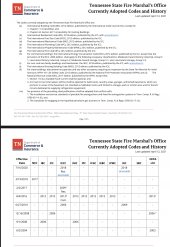
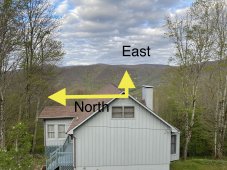


Took pictures of the area below the cabin for ground mounts at various times. I think between two areas (array by cabin deck) and another array between the two pine trees below service road, I can get suncoverage between 09:00 and 17:00. Might be a slight gap in production. No idea how to burry the wire but will figure it out. Thoughts on this?
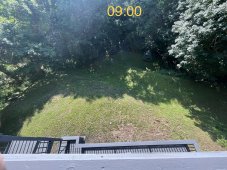
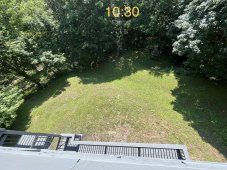
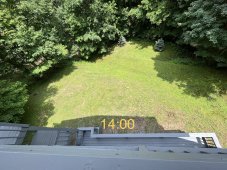

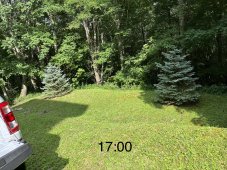





Solar Guppy
Red Cobra Guppy
In the Summer possibly, but come winter, I would be surprised it you got even 3 hours.
I found this tool, which uses google maps of your area of interest, and within a few minutes you can create shapes for tree groups and specify the heights, the pan through a day for any time of the year and it shows the shadow cast by the objects drawn.
You can then compare to roof mount, which really is what you should be doing, to many tall trees on the ground for solar.
Note, when you do a run for the roof, subtract the height of the roof for the object group you have created.
I found this tool, which uses google maps of your area of interest, and within a few minutes you can create shapes for tree groups and specify the heights, the pan through a day for any time of the year and it shows the shadow cast by the objects drawn.
You can then compare to roof mount, which really is what you should be doing, to many tall trees on the ground for solar.
Note, when you do a run for the roof, subtract the height of the roof for the object group you have created.
12VoltInstalls
life passes by too quickly to not live in freedom
Answer:If you have that much wind why not use wind generation instead of solar.
It’s not constant but when storms roll in up here they are pretty wicked. I’ve tried a few expensive weather stations to track wind velocity but they get destroyed after a few storms. It’s not uncommon to get 120mpg gusts in the winter.
12VoltInstalls
life passes by too quickly to not live in freedom
With lithium batteries that don’t care if they’re partial charged for long periods a single directional array (parallel with red line) is your best max potential of collection. The yellow lines could be the angles to extend your harvest day like up above or wherever- separate strings, separate controller for each.think between two areas (array by cabin deck) and another array between the two pine trees below service road, I can get suncoverage between

Contact someone like https://practicalpreppers.com/consultation/.. I don't think they'd have issue installing on that roof. If that roof keeps having to be replaced because of the weather I'd highly suggest using metal roofing next time.
Was thinking about contacting him. The only metal roof that will last here is standing seam and that would cost $40k. Chose a GAF high wind certified single system with 50 year non-prorated warranty for $8k. The other 32k is now earmarked for solarContact someone like https://practicalpreppers.com/consultation/.. I don't think they'd have issue installing on that roof. If that roof keeps having to be replaced because of the weather I'd highly suggest using metal roofing next time.
Having known people dealing with those warranties I can tell you they do everything possible to find a way not to honor itwith 50 year non-prorated warranty
There were certified contractor by GAF and for repair. Made sure i had that all up front. You all have me convinced the south side roof is the best way if I’m going to do this. Still worried about chimney shading for a few hours. The. Ext challenge is getting someone to do it. Again may give practical preppers a call. The company that installed roof will install solar (not on mine) only do enphase which is not what I want.Having known people dealing with those warranties I can tell you they do everything possible to find a way not to honor itit also needs to have been installed by someone who took the special training by GAF to be certified as a "Master Elite" contractor.
Hedges
I See Electromagnetic Fields!
- Joined
- Mar 28, 2020
- Messages
- 20,522
Installing Enphase microinverters and installing RSD boxes shouldn't be much different.
RSD even simpler, up to a certain number all are daisy chained together with MC4.
Maybe you could get them to do that portion of the install, as far as connecting through MC4 home-run cables through a conduit to inverter disconnect box. You do the balance at ground level.
That is assuming high-voltage string. If you're doing multiple lower voltage to SCC, of course series/parallel needs to be followed.
RSD even simpler, up to a certain number all are daisy chained together with MC4.
Maybe you could get them to do that portion of the install, as far as connecting through MC4 home-run cables through a conduit to inverter disconnect box. You do the balance at ground level.
That is assuming high-voltage string. If you're doing multiple lower voltage to SCC, of course series/parallel needs to be followed.
I'm not in favor of doing a ground mount at this location (I agree with other to do it on the south facing roof as it will also help protect your shingles), but if you were to do a ground mount... I would look into running the wires on a pole instead of trying to bury in rock.
Similar threads
- Replies
- 23
- Views
- 765
- Replies
- 24
- Views
- 968
- Replies
- 17
- Views
- 841
- Replies
- 5
- Views
- 286


